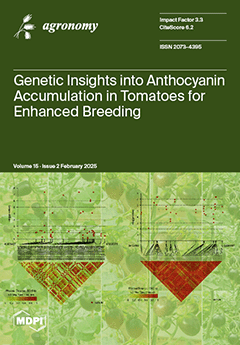The degree of soil salinization is still on the rise. In saline environments, NaCl is the main substance that causes plant salt damage, with the toxicity of ions under salt stress primarily involving sodium (Na
+) or chloride (Cl
−). However, fewer studies have focused on Cl
− stress. This study investigated the differences in the growth and physiology of five blueberry varieties under Cl
− stress, aiming to understand the mechanisms of Cl
− tolerance and the physiological responses to Cl
− stress in these varieties. Five blueberry varieties (‘Northland’, ‘PL19’, ‘Duke’, ‘Reka’, and ‘Bonnie’) were used as test materials. This study examined the changes in growth and physiological indices of blueberry plants under different concentrations of Cl
− (A1–A6: 50, 100, 150, 200, 250, and 300 mmol/L) treatments. A control treatment (CK) was included to serve as a baseline for comparison. We comprehensively evaluated the Cl
− tolerance of these five varieties to screen for chlorine-tolerant varieties. This study examined the concentration-dependent changes in growth and physiological indices of blueberry plants, including plant height, leaf area, chlorophyll content, electrical conductivity, levels of soluble sugar (SS), malondialdehyde (MDA), proline (Pro), and soluble protein (SP), as well as the activities of superoxide dismutase (SOD) and catalase (CAT). The results revealed that as the Cl
− concentration increased, the growth of all blueberry varieties was inhibited; plant height, leaf area, and chlorophyll content consistently declined, whereas electrical conductivity showed a steady increase. SS and MDA content exhibited a biphasic response, with an increase at lower Cl
− concentrations followed by a decrease at higher concentrations. The activities of SOD and CAT in ‘Duke’ consistently increased with rising Cl
− levels. In ‘PL19’ and ‘Reka’, chlorophyll content decreased with increasing Cl
−, while their proline content rose initially and then declined. In contrast, the other varieties generally showed an increasing trend in proline content. Similarly, the soluble protein content of ‘Northland’ and ‘PL19’ increased at lower Cl
− levels and decreased at higher concentrations, whereas ‘Bonnie’, ‘Duke’, and ‘Reka’ displayed an overall declining trend. Principal component analysis indicated that the Cl
− tolerance of the blueberry varieties ranked as follows: ‘Duke’ > ‘Bonnie’ > ‘Reka’ > ‘PL19’ > ‘Northland’. These findings lay a foundation for blueberry cultivation in saline–alkaline soils and support the selection and development of new, chlorine-tolerant varieties.
Full article





